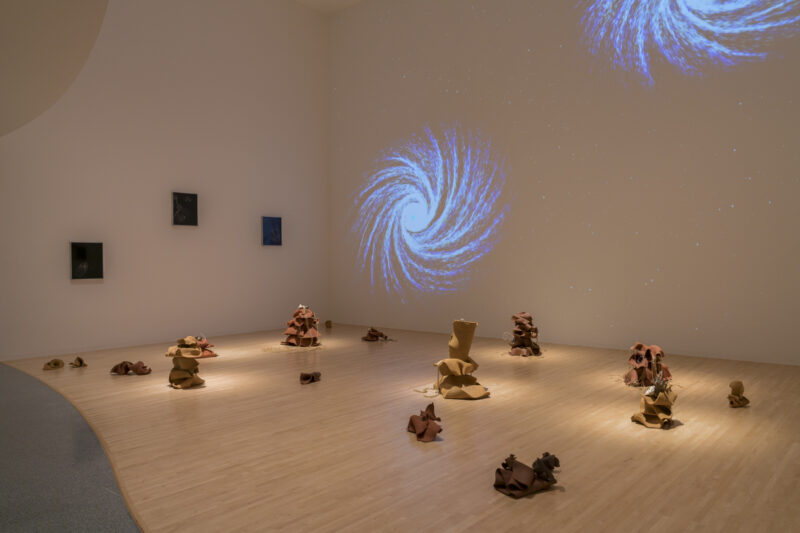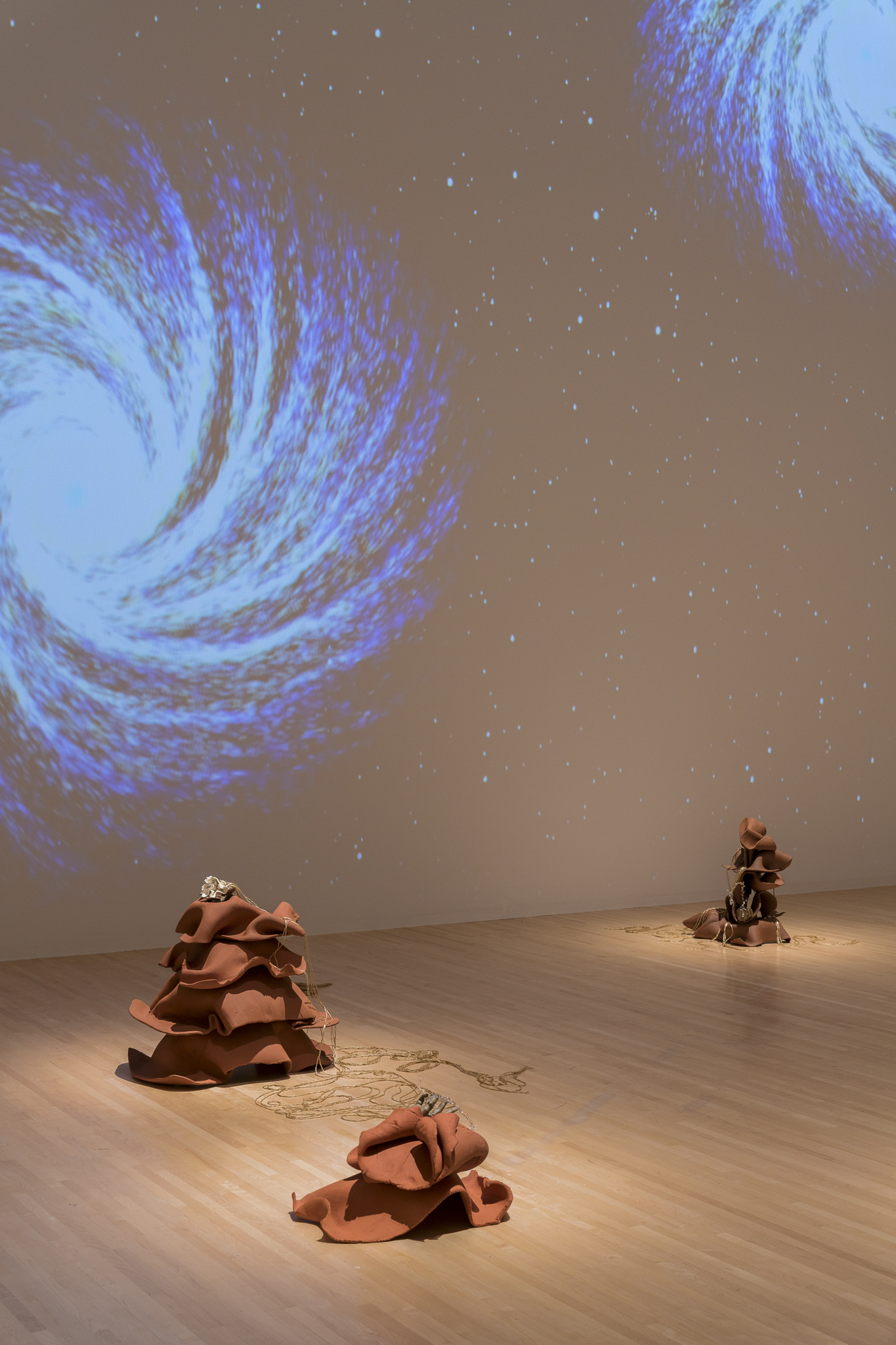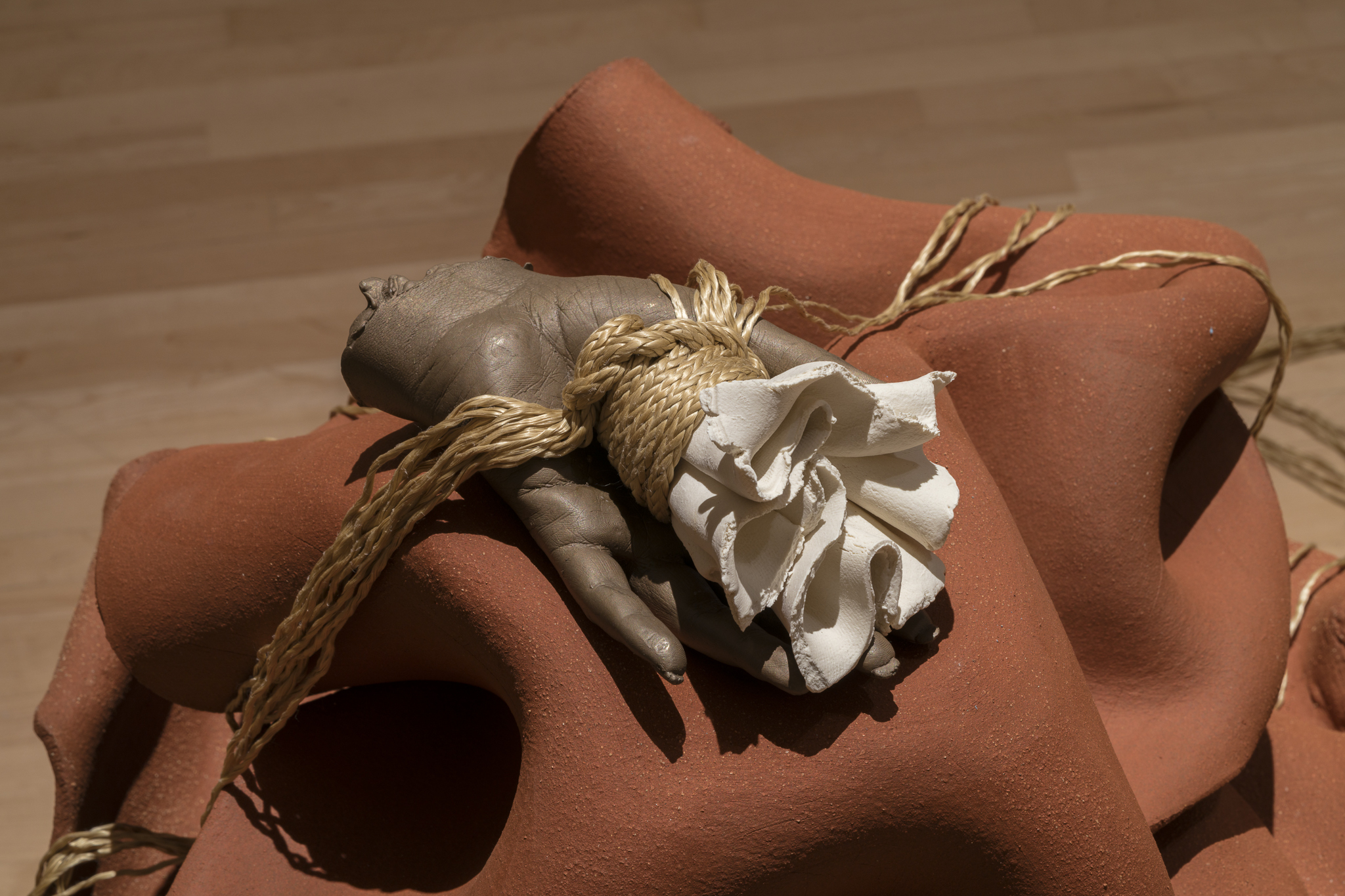The Immortalization of the Impermanent
Review of Kelly Akashi: Encounters at Henry Art Gallery
Written by TeenTix Newsroom Writer Sylvia Jarman and edited by Teen Editorial Staff Member Audrey Gray

How does one immortalize something impermanent? How does one create a physical form for something theoretical? When confronted with emotions and ideas so inexpressible it’s entirely overwhelming, how does an artist convey them clearly through art? On September 29, I had the privilege of attending the public opening of the Henry Art Gallery’s fall exhibits, where I was able to witness L.A.-based artist Kelly Akashi’s newest exhibition, Encounters. The ethos of Encounters explores humanity’s interaction and connection with its surroundings: nature, the unknown, and each other. These interactions are by definition fleeting; small moments in time in which two bodies, whether human, terrestrial, or celestial, are intertwined through touch. Akashi’s sculptures give these impermanent interactions a permanent existence, creating a body for something formless.
The exhibition can be found on the bottom floor of the Henry, taking up a sizable portion of the space. Visitors are encouraged to walk amongst Akashi’s sculptures, carefully displayed across the gallery space. These sculptures are not displayed on pedestals or behind glass as in a traditional gallery but are rather placed directly on the floor. The proximity to the art makes the viewer feel as if the sculptures they are encircling and studying are merely other members of the crowd. The sculptures themselves are mounds of clay, carefully folded in a way evocative of the very earth the clay came from. Many of the sculptures are topped by bronze casts of the artist’s hands; some hold folded flower-like items, others coiled ropes, and others delicate blown-glass branches. Along the walls of the space are prints of Akashi’s work, showing a unique form of photography in which crystals are grown on film. Finally, projected across the back wall of the gallery is simulated footage of the collision of the Andromeda and Milky Way galaxies, creating an optical illusion as the back wall appears to expand, making the viewer feel miniscule in comparison.

Though many of Akashi’s pieces are sculptures, she often integrates elements from her background in photography in her works. The same can be said about her interest in scientific fields, such as biology and botany. Science and art are often thought of as antithetical, but Akashi subverts this idea, perfectly blending the two through her art. Akashi integrates the two fields through the form her art takes, an artistic mimicry of the natural bodies studied in geology and biology. The delicate folds of the clay towers seen in Encounters are evocative of many things; hills and valleys, rifts, and winding rivers. The art feels like a conduit for the earth itself. Akashi, like many other artists with a penchant for the scientific, is able to create such naturalistic figures because of her intimate knowledge of the natural world. The very nature of these fields is to capture things as they truly are; having experience with this viewpoint gives an artist a more objective lens.
Akashi utilizes this objectivity to create form for the nebulous ideas behind Encounters, aiming to preserve interactions and concepts that have no tangible form. Nature never holds still–it is constantly changing. Physical touch is such an impermanent thing, always fluctuating and changing, and it thus has no uniform depiction. Yet Akashi’s work evokes this constant state of fluctuation with still imagery, managing to pin down something that is always shifting. The clay mounds perfectly capture a moving wave or tectonic shift while remaining entirely stationary, much like a photograph would. The cast hands are posed in ways that are uncannily familiar, so the viewer feels as though they are living a memory of previous interactions when seeing them. Even the imperceptible and momentary are portrayed with intentionality. Nothing is obfuscated or left out of Akashi’s depiction of connection.
Akashi’s craftsmanship is undeniable; it is a marvel to see how she has transformed the materials of the sculptures seen in this exhibit. She possesses an uncanny ability to make the lifeless feel alive, animating the pieces that make up each sculpture. She is able to transform traditionally intractable and heavy mediums like clay, bronze, and glass into weightless objects; gentle, soft, almost lifelike, creating a sort of constructed naturalism. One sculpture in particular provides an example of this: a small pillar of clay topped by a hand, outreached and holding a delicate porcelain flower wrapped in rope, displayed near the center of the exhibit. The gesture of the hand that has been immortalized is lifelike and human–the viewer wants to reach out and accept the porcelain flower. The clay is folded so that it still looks fresh and pliable, as if Akashi had done nothing to transform it, presenting it as she had naturally found it. And yet, if the viewer were to actually reach out and touch the art, they would feel something cold, hard, and inanimate, a demonstration of Akashi’s artisanship and ability to breathe life into the inanimate.

The only complaint I can muster is that the exhibit felt too small. Having seen Akashi’s previous exhibition at the Frye Art Museum, entitled Formations, I went into Encounters expecting something of a similar scale. However, Encounters is restricted to the small gallery space that it occupies, and I believe that limits it. The smaller scale of the exhibition draws attention away from some of the other aspects of it. The inclusion of crystallography was intriguing, but it felt a little incongruous with the themes of Encounters, as it belonged in another exhibit. Rather than tying the whole gallery together, the crystallography throws it off-kilter. It seems as though Akashi tried to surpass the size of the gallery and accomplish too much–because of this, there are too many moving pieces of the gallery that do not connect, and at times it feels as though the viewer is left to make up some of the meaning that had been lost as a result of this. Akashi is still able to successfully express the ideas behind Encounters, but I would have loved to see it given the proper amount of space to truly flourish.
Encounters is a perfect combination of scientific knowledge and philosophical inquiry, providing an incredibly meaningful experience. Akashi is a powerhouse of a contemporary artist, demonstrating mastery over many mediums and effortlessly conveying complex theories of how living things interact and how we interpret those interactions. Any complaints that I had regarding the scale of the exhibition are dwarfed by my infinite regard for the meaning and execution of Encounters, as well as for Akashi’s undeniable skill. I feel as though I left the gallery with a newfound appreciation for the small, ephemeral, and momentary. Encounters has the viewer question the true scale of their existence, and how integral things that may seem fleeting truly are. A passing wave, the wind against the trees, a gift or offering, a single moment in time. They are small, impermanent moments, but once they pass they cannot be recreated. And yet, they still hold the same weight as the collision of two worlds, like Andromeda and the Milky Way. All are interactions, all are connections, as Akashi aims to immortalize through Encounters.
Lead Photo Credit: Kelly Akashi: Encounters [Installation view, Henry Art Gallery, University of Washington, Seattle.2023]. Photo: Jueqian Fang.
The TeenTix Newsroom is a group of teen writers led by the Teen Editorial Staff. For each review, Newsroom writers work individually with a teen editor to polish their writing for publication. The Teen Editorial Staff is made up of 5 teens who curate the review portion of the TeenTix blog. More information about the Teen Editorial Staff can be found HERE.
The TeenTix Press Corps promotes critical thinking, communication, and information literacy through criticism and journalism practice for teens. For more information about the Press Corps program see HERE.


